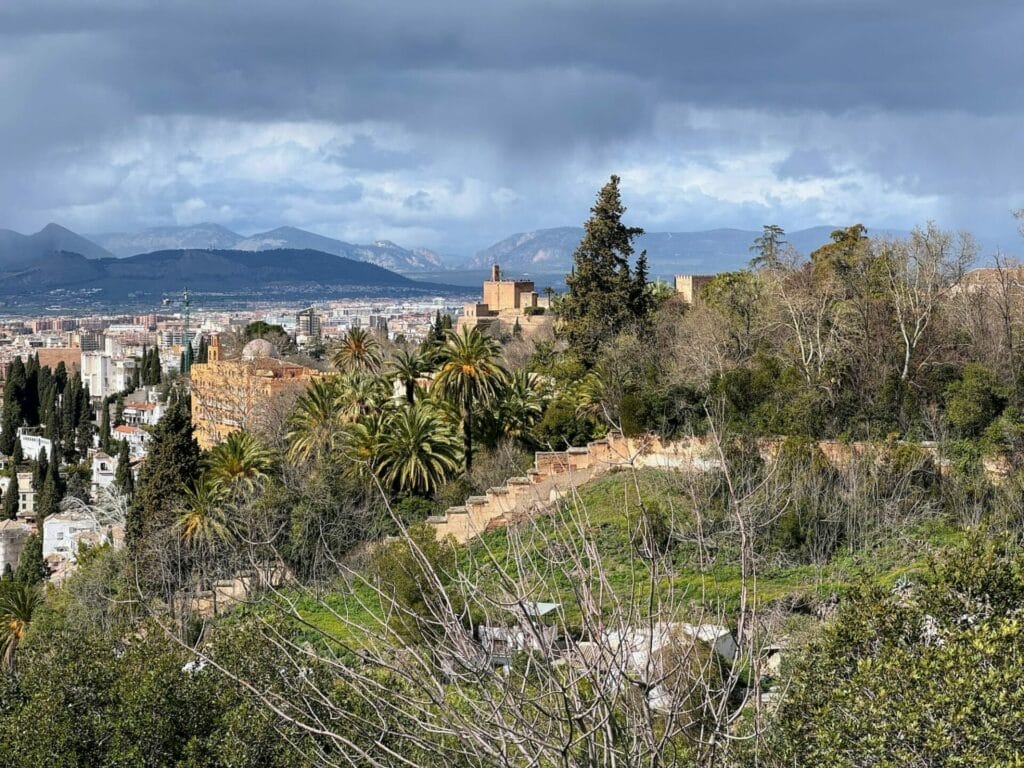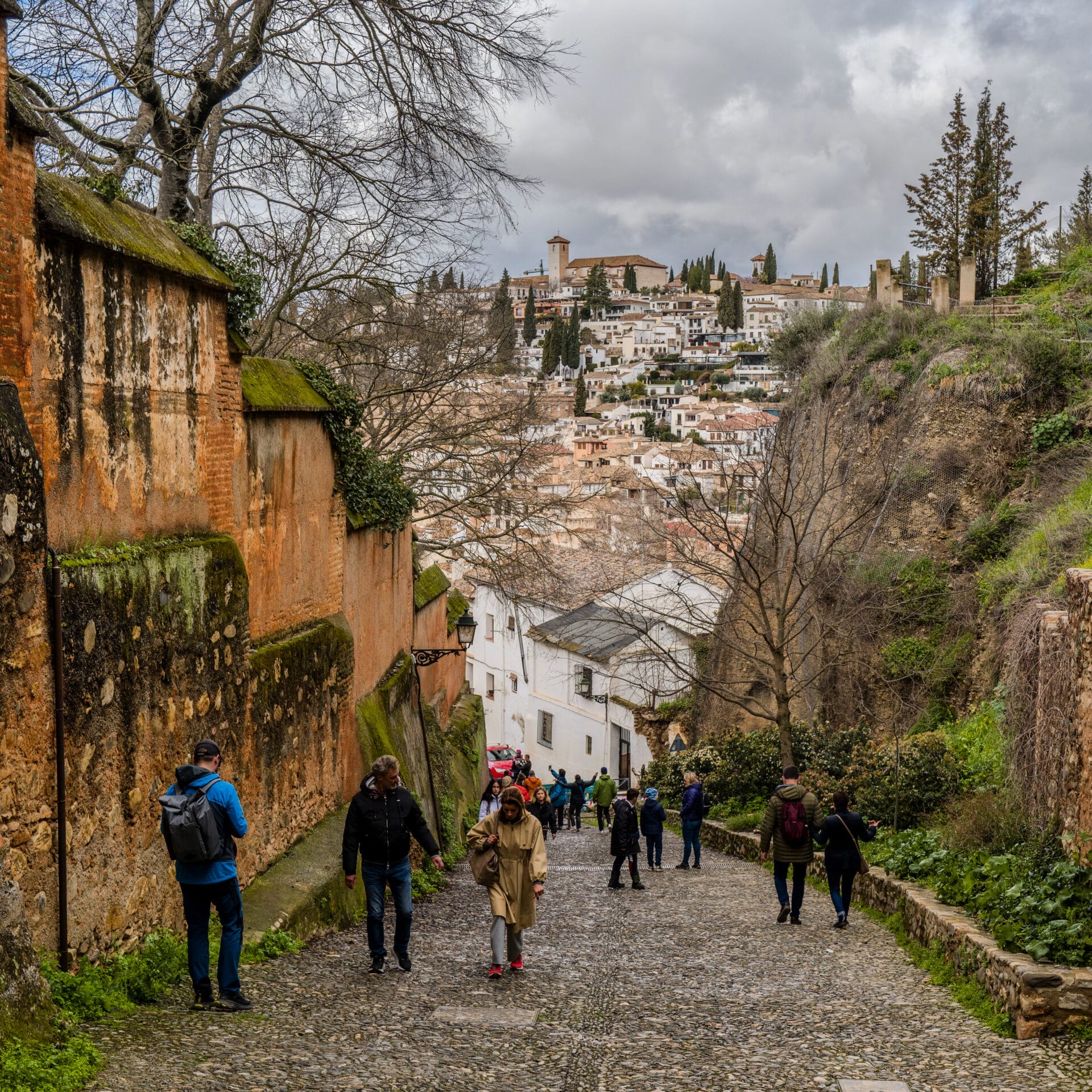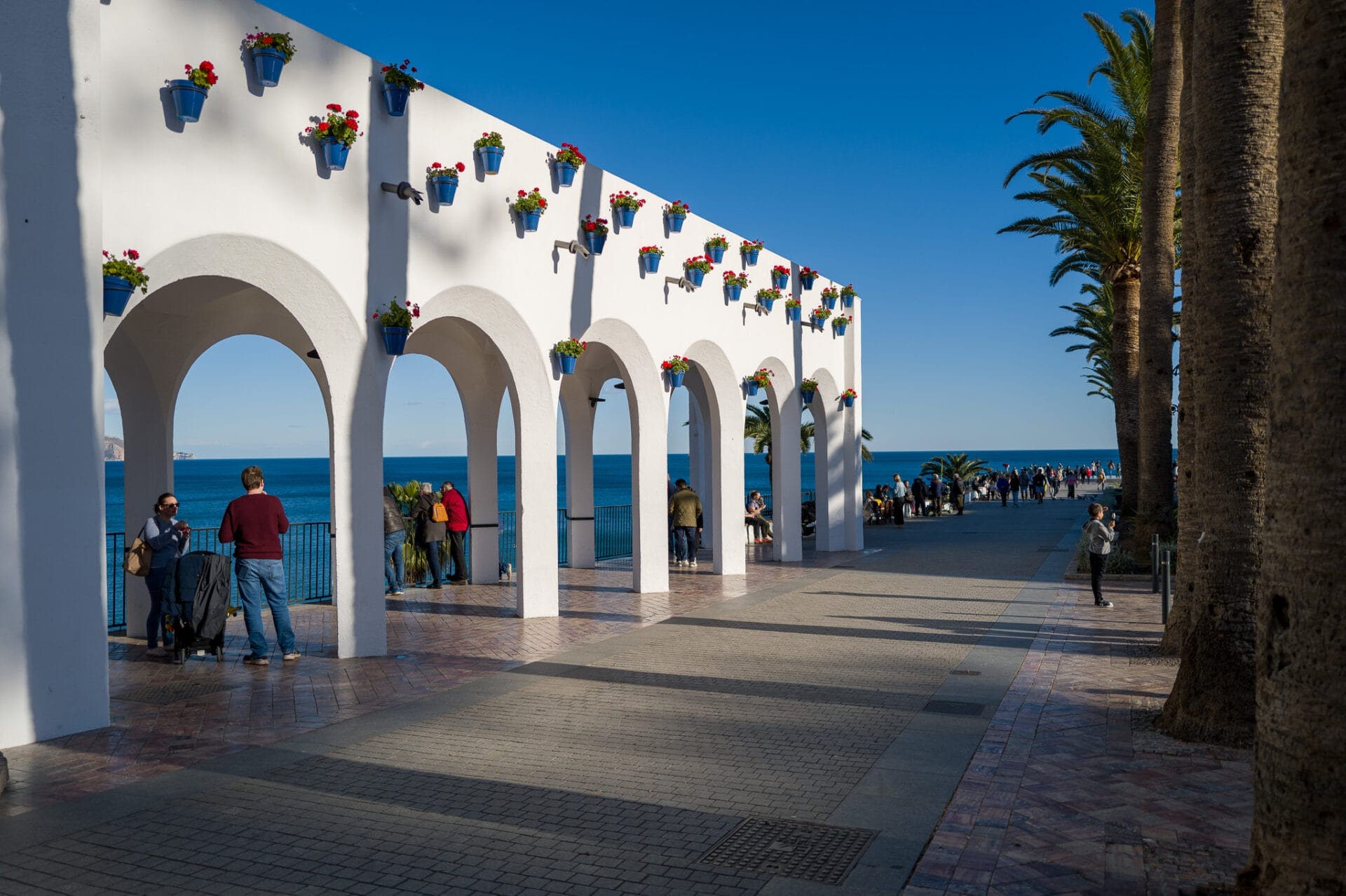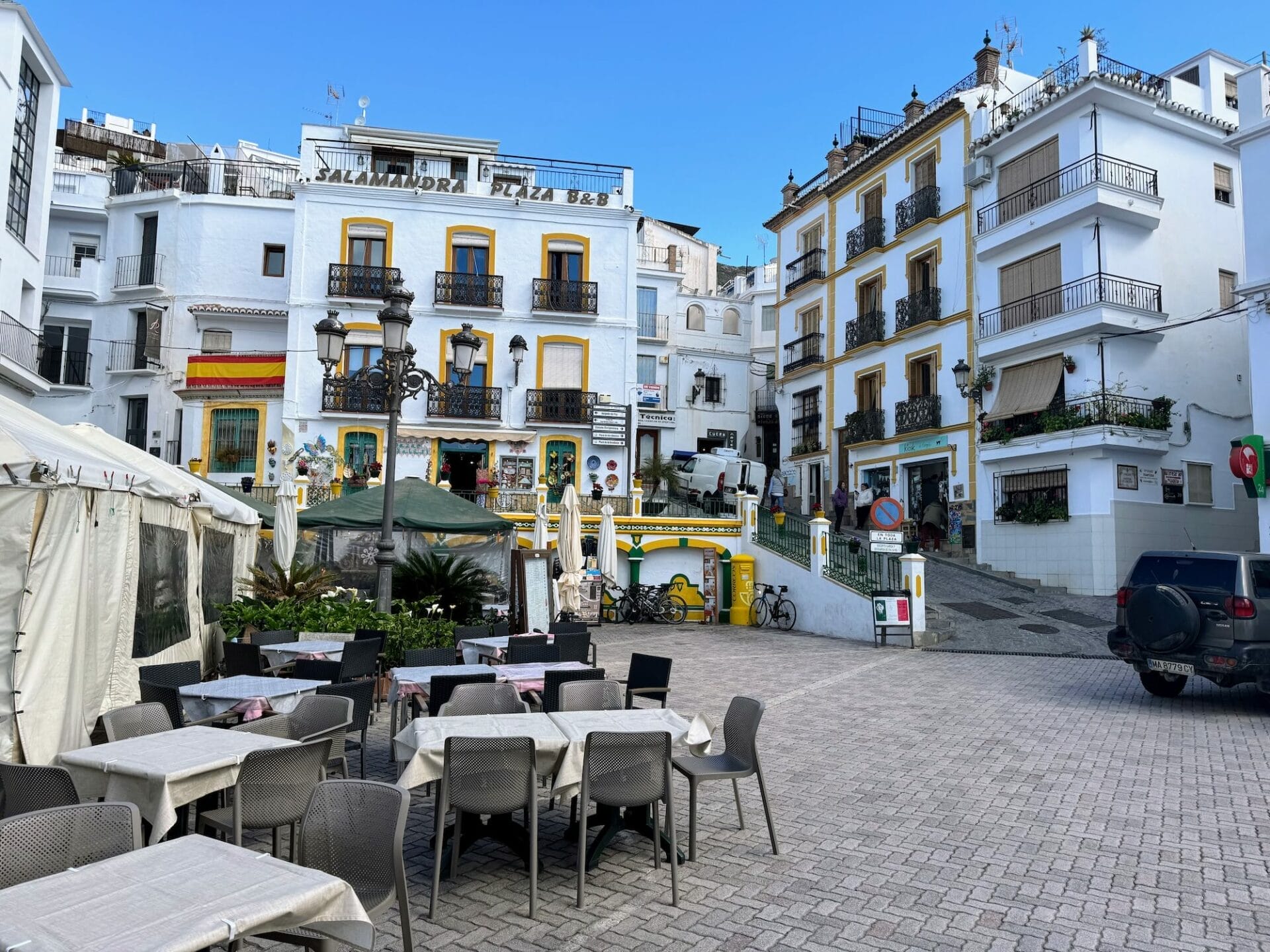Granada Moorish Heritage – Nestled at the foot of the Sierra Nevada mountains, Granada stands as a testament to Spain’s rich Moorish heritage and vibrant cultural tapestry. This city, where the whispers of the past meet the vitality of the present, invites travelers to embark on a journey through time, uncovering layers of history etched into its streets and edifices. But where in Spain is Granada, you might ask? It’s located in the southern region of Andalusia, a land of flamenco, tapas, and endless sunshine, offering a glimpse into Spain’s soul.
Granada’s enchantment begins with its crown jewel, the Alhambra Palace, a sprawling fortress complex that exemplifies Moorish art and architecture’s beauty and intricacy. Yet, the allure of Granada extends beyond the Alhambra’s ancient walls. The city is a mosaic of winding alleys, hidden courtyards, and vibrant bazaars, each telling a story of conquest, coexistence, and creativity.
What to see in Granada Spain? is a question with countless answers. From the historic Albaicín quarter, a UNESCO World Heritage site, to the flamenco caves of Sacromonte, Granada offers a plethora of sights and experiences that captivate the senses and ignite the imagination. The city’s culinary scene, with its fusion of traditional Andalusian flavors and contemporary innovations, invites visitors to savor every bite of their journey.
As travelers ponder “how many days in Granada?” the answer becomes clear: every moment spent in this city is an opportunity to discover something new, be it a hidden garden, an artisan workshop, or a breathtaking view of the Alhambra against the backdrop of the Sierra Nevada. Granada is not just a destination; it’s a journey into the heart of Andalusian culture, history, and art.
Embarking on this journey, we invite you to explore Granada’s enchantment, to wander its ancient streets, to lose yourself in its beauty, and to find in its embrace a connection to the past that continues to inspire and enchant travelers from around the world. Welcome to Granada, a city where every corner holds a story, every sunset promises magic, and every visit leaves a lasting impression on the soul.

Chapter 1: The Crown Jewel of Granada – Alhambra Palace
Nestled atop the rolling hills of the Sierra Nevada, the Alhambra Palace is a testament to Granada, Spain’s rich cultural tapestry. This architectural marvel, often referred to as the “Red Castle” due to its sun-kissed walls at sunset, is not just a palace but a sprawling fortress that encompasses royal palaces, serene patios, and lush gardens, each telling its own story of a bygone era.
The origins of the Alhambra are as fascinating as its architecture. Initially constructed as a small fortress in 889 AD on the remnants of Roman fortifications, it was rebuilt in the mid-13th century by the Nasrid emir Mohammed ben Al-Ahmar. This marked the beginning of the Alhambra’s golden age, transforming it into a royal palace in 1333 by Yusuf I, Sultan of Granada. The Alhambra then became the last stronghold of the Spanish Moors, a symbol of the flourishing Islamic culture in medieval Spain.

Walking through the Alhambra, one is immediately enveloped by the intricate beauty of Islamic art and architecture. The Nasrid Palaces, the heart of the Alhambra, are adorned with intricate stucco work, stunning tilework, and arabesque patterns that speak volumes of the craftsmanship of the time. The Palace of the Lions, with its famous courtyard and marble fountain supported by lions, is an emblem of architectural innovation and artistic mastery.
The Generalife, a villa with lush gardens, served as a retreat for the Granadan monarchs. Its tranquil ambiance and the sound of water from its many fountains reflect the Islamic concept of paradise. Here, amidst the myrtles, oleanders, and cypresses, one finds a peaceful escape, offering a glimpse into the leisurely lifestyle of the palace’s erstwhile inhabitants.
The strategic significance of the Alhambra is evident in its military components, including the Alcazaba, the oldest part of the complex. This military zone provided a formidable defense system, showcasing the importance of the Alhambra as a citadel and royal residence.
The Alhambra’s influence extends beyond architecture and history; it has inspired countless artists, poets, and writers over the centuries. Washington Irving’s “Tales of the Alhambra” is perhaps the most famous literary work inspired by the palace, capturing its enchanting allure and the myriad legends that surround it.
Today, the Alhambra is a UNESCO World Heritage Site, attracting millions of visitors from around the globe. Its preservation efforts ensure that this jewel of Islamic art and architecture continues to captivate and educate future generations, standing as a beacon of cultural harmony and artistic achievement.
The Alhambra Palace, with its rich history, architectural grandeur, and cultural significance, remains the crown jewel of Granada. It is not just a monument but a living legacy of the sophisticated Moorish civilization in Spain, offering a window into the past and a source of inspiration for the future.

Chapter 2: Beyond the Alhambra – What to See in Granada, Spain
Granada is synonymous with the Alhambra, a city steeped in history and culture. However, the allure of Granada extends far beyond this iconic fortress. This chapter explores the myriad of attractions that Granada offers, ensuring visitors capture the essence of this enchanting city.
1. The Historic Albaicín District
Perched on a hill opposite the Alhambra, the Albaicín is a labyrinth of narrow streets and whitewashed houses. This ancient Moorish quarter, a UNESCO World Heritage site, is a testament to Granada’s rich Islamic past. Strolling through the Albaicín is like walking back in time, with its traditional tea shops, vibrant bazaars, and stunning views of the Alhambra from the Mirador de San Nicolás.
2. Capilla Real de Granada
Adjacent to the grand Granada Cathedral lies the Royal Chapel of Granada, the final resting place of Catholic Monarchs Ferdinand and Isabella. The chapel, a masterpiece of Spanish Renaissance architecture, houses the monarchs’ magnificent tombs, meticulously carved by Domenico Fancelli. It’s a poignant reminder of Spain’s complex history, intertwining faith, power, and artistry.
3. Granada Cathedral
The Granada Cathedral, or Catedral de Granada, stands as a monument to Christian triumph in Granada. This colossal structure, notable for its bright Renaissance interior and imposing façade, departs from the city’s Moorish architectural tradition. The cathedral’s intricate Capilla Mayor (main chapel) and numerous chapels adorned with artworks are a feast for the eyes.
4. Sacromonte
Sacromonte, the traditional home of Granada’s Roma community, is famous for its cave houses embedded in the hills. These caves, once the abode of miners and laborers, now host flamenco shows that capture the spirit of Andalusian culture. The Museo Cuevas del Sacromonte provides insights into the area’s history and the unique cave-dwelling lifestyle.
5. Parque de las Ciencias
Granada’s science park, Parque de las Ciencias, offers a different kind of cultural experience. This interactive museum is devoted to science and technology, featuring exhibitions on the human body, the universe, and more. It’s a fascinating destination for families, with a planetarium, butterfly house, and observation tower providing panoramic views of Granada.

6. Monasterio de San Jerónimo
The Monastery of San Jerónimo is a hidden gem in Granada. Founded by the Catholic Monarchs, this monastery showcases Spanish Baroque art. The stunning main altar, adorned with gold leaf, and the serene cloister with its beautifully painted frescoes, make it a must-visit for art and history enthusiasts.
7. Carrera del Darro
One of Granada’s most picturesque streets, the Carrera del Darro, runs alongside the Darro River. Flanked by historic buildings and ancient bridges, a walk along this cobblestone street offers a glimpse into Granada’s medieval past. It’s the perfect route for a leisurely stroll, leading to many of the city’s historic sites and providing a tranquil escape from the hustle and bustle.
Granada is a city where every corner tells a story, from its Moorish heritage to its Renaissance splendor. Beyond the Alhambra, Granada reveals its diverse history, vibrant culture, and the indomitable spirit of its people. Visitors leave with a deep appreciation for this city, where the past and present coalesce into an unforgettable experience.
Chapter 3 of the guidebook Savoring Granada – A Culinary Odyssey
Delves into Granada’s rich and diverse culinary landscape, offering travelers a gastronomic journey through the city’s traditional dishes, modern cuisine, and unique dining experiences. This chapter provides a comprehensive guide for food enthusiasts eager to explore Granada’s culinary offerings, from historic taverns and markets to contemporary restaurants and bars.
The chapter introduces readers to the historical context of Granada’s cuisine, highlighting the influence of Moorish, Christian, and Jewish culinary traditions on the city’s gastronomy. It outlines must-try traditional dishes, such as “piononos,” “tortilla del Sacromonte,” and “habas con jamón,” providing insights into their origins and significance in Granadan culture.
Following the traditional culinary exploration, the chapter transitions to the modern dining scene in Granada, showcasing innovative restaurants that fuse traditional flavors with contemporary techniques. It emphasizes the importance of locally sourced ingredients and the growing trend of farm-to-table dining experiences in the city.
An essential part of Granada’s culinary culture is its tapas scene, and the chapter dedicates a section to navigating the city’s tapas bars. It offers practical tips on how to order tapas like a local, including recommendations for specific bars known for their unique offerings and atmosphere.
The chapter also explores Granada’s markets and food festivals, encouraging visitors to immerse themselves in the local food culture. It highlights the San Agustín Market as a must-visit destination for those looking to sample fresh produce and artisanal products.
For travelers seeking a hands-on culinary experience, the chapter includes information on cooking classes and food tours available in Granada. These experiences offer an opportunity to learn about traditional cooking techniques and ingredients, enhancing the overall gastronomic journey.
Savoring Granada – A Culinary Odyssey concludes with a directory of recommended restaurants, bars, markets, and culinary experiences, complete with contact information and brief descriptions. This chapter serves as an invaluable resource for travelers looking to indulge in Granada’s culinary delights, ensuring a memorable and flavorful exploration of the city’s gastronomy.

CasaPatrona: Granada’s Gastronomic Gem
An Unforgettable Ambiance
At CasaPatrona, nestled in the Centro district at C. Virgen del Rosario, 10, 18009 Granada, Spain, every meal is an affair to remember. This top-tier restaurant, which we stumbled upon while strolling through Granada’s enchanting streets, quickly became our culinary sanctuary. Its lovely terrace, set against a buzzing and cool neighborhood backdrop, offers a warm welcome that pairs perfectly with the sophisticated menu offerings.

Culinary Delights
Razor Clams and Wakame
The menu at CasaPatrona is a canvas of creativity and tradition. The razor clams laid on a bed of wakame were a highlight, perfectly seasoned and melding the ocean’s freshness with the earthiness of Japanese seaweed. It was a dish that captured the essence of fusion cuisine done right.

The image showcases a dish served in a terracotta bowl, often characteristic of traditional Spanish cuisine. The dish contains a variety of components with a rich and flavorful experience.
- Eggs: There are sunny-side-up eggs with yolks that are still runny. The dish was served hot and fresh from the kitchen.
- Chorizo: Slices of chorizo are visible, which add a smoky and spicy flavor profile to the dish.
- Potatoes: The base of the dish is made of potatoes, which look to be cooked until tender, possibly roasted or fried, to add a comforting and filling element.
- Tomato Sauce: The potatoes and other components sit with a tomato-based sauce, adding moisture and a tangy sweetness to the dish.
- Garnishes: Scattered across the top are what seem to be nuts, possibly cashews, and black sesame seeds, which contribute an additional texture and nutty flavor.
- Chorizo Oil: The glistening sheen over the dish uses chorizo oil to infuse it with a deep, paprika-rich essence.
The composition of the dish, with its vibrant colors and mix of textures, along with the visible oil droplets, speaks to a meal designed to satisfy with a balance of flavors ranging from the umami and tartness of the tomato sauce to the savory depth of the chorizo and the richness of the eggs. The dish’s presentation on a simple yet elegant countertop suggests a casual dining atmosphere that prioritizes the quality and heartiness of the food.
The Suckling Pig
The Melting Tenderness
The suckling pig was a revelation, its melting tenderness a result of the meticulous slow cooking process. Accompanied by a side of crunchy asparagus, it was a testament to the harmonious balance of textures and flavors that CasaPatrona masters.
A Dessert Surprise
Cheesecake Reinvented
The cheesecake, a delightful surprise, underscored CasaPatrona’s dedication to fresh and local ingredients. Each bite was a testament to the restaurant’s ethos of quality and a celebration of Andalusian produce.
Top Picks from the Menu
Sangria, Tortilla, and More
My top picks from our visits—yes, we had to go back for seconds—include the white sangria, refreshing and perfect for the Granadan climate; the tortilla, elevated by the addition of grilled octopus; the beef ribeye, a masterpiece of meat preparation; and the hazelnut chocolate cake, a dessert so divine it could very well be the final word in chocolate decadence.
Final Thoughts
Highly recommended for its exceptional value, attentive service, and a menu that captivates and delights, CasaPatrona is a divine dining destination in Granada. It’s a place where sophisticated tapas and generous main courses meet to celebrate the palate, making it an essential stop for anyone visiting this beautiful Andalusian city.
Chapter 4 of your travel guide to Granada, titled Granada’s Hidden Gems
Off the Beaten Path, delves into the less-traveled corners of this enchanting city, revealing places that are often overlooked by the typical tourist trail. This chapter encourages travelers to explore beyond the renowned Alhambra and dive into the heart of Granada’s unique charm, uncovering its secret treasures.
Granada’s Hidden Gems – Off the Beaten Path
Granada, a city of undeniable charm and history, is best known for the majestic Alhambra. However, the true essence of Granada lies in its hidden corners, waiting to be discovered by those willing to stray off the beaten path. This chapter will guide you through the city’s lesser-known yet equally captivating attractions, offering a glimpse into the soul of Granada.
1. Carmen de los Mártires Gardens
Just a stone’s throw away from the Alhambra, the Carmen de los Mártires Gardens offer a tranquil escape from the city’s bustle. These romantic-style gardens, with their lush greenery, ornate fountains, and serene ponds, provide a peaceful haven for leisurely strolls and reflection.
2. Sacromonte’s Cave Homes
The hillside neighborhood of Sacromonte is famous for its cave homes, which have been inhabited since the 16th century. Today, these caves serve as residences, flamenco venues, and even museums, offering a unique insight into Granada’s cultural heritage.
3. Corral del Carbón
The Corral del Carbón, an ancient caravanserai, is a hidden gem in the heart of Granada. This beautifully preserved Moorish building once housed merchants and their goods and now hosts cultural events and exhibitions, transporting visitors back in time.
4. El Bañuelo
Tucked away on the banks of the Darro River, El Bañuelo is one of the best-preserved Arab baths in Spain. This 11th-century bathhouse, with its stunningly intricate arches and serene atmosphere, offers a rare glimpse into Islamic Granada.
5. Monasterio de San Jerónimo
A short walk from the city center lies the Monasterio de San Jerónimo, a Renaissance masterpiece often overlooked by tourists. The monastery’s cloister, adorned with detailed frescoes and sculptures, is a testament to Granada’s rich artistic heritage.
6. Fundación Rodríguez-Acosta
The Fundación Rodríguez-Acosta, once the home and studio of painter José María Rodríguez-Acosta, is now a museum showcasing his works and personal collection. The foundation’s gardens, blending traditional Andalusian and modernist elements, offer stunning views of the Alhambra and the Sierra Nevada.
7. Calle de las Teterías
For a taste of Granada’s multicultural vibe, wander down Calle de las Teterías, or Tea Street. This narrow alley, lined with Moroccan tea shops and artisan stores, transports visitors to the heart of North Africa, offering an array of exotic teas, spices, and handicrafts.
8. Huerta de San Vicente
The Huerta de San Vicente was the summer home of the Lorca family and is now dedicated to Federico García Lorca, one of Spain’s most celebrated poets and playwrights. The house museum, surrounded by tranquil gardens, provides an intimate look into Lorca’s life and works.
This chapter invites readers to step off the well-trodden path and immerse themselves in the lesser-known aspects of Granada’s culture and history. By exploring these hidden gems, travelers can experience the city’s authentic beauty and uncover the stories that make Granada truly unforgettable.

Chapter 5 of the guidebook, Planning Your Stay – How Many Days in Granada?
Advises travelers on the ideal duration for a visit to Granada to fully experience its rich cultural heritage and attractions. The chapter suggests a minimum stay of two days to explore the city’s must-see sites, including the Alhambra, Generalife Gardens, and the Albaicín district. For those with a keen interest in delving deeper into Granada’s history and enjoying its leisure activities, an extended stay of three to four days is recommended. This allows for a more relaxed exploration of the city’s lesser-known gems, such as the Sacromonte district, as well as time to enjoy local cuisine and entertainment. The guidebook emphasizes the importance of planning and booking tickets to popular attractions like the Alhambra in advance to ensure availability.
Chapter 6: Night in Granada – Experiencing the City After Dark
Granada, with its historic charm and vibrant culture, transforms as the sun sets, unveiling a nocturnal panorama that beckons travelers and locals alike. This chapter delves into the unique experiences that make Granada’s nightlife unforgettable, from the softly lit cobblestone streets of the Albaicín to the lively tapas bars and flamenco venues that pulse with the heart of Andalusian tradition.
Tapas Hopping in Granada
Granada is renowned for its tapas culture, a culinary tradition where every drink at a bar comes with a small, complimentary dish. As night falls, the city’s tapas bars become lively gathering spots where the air is filled with the clinking of glasses, laughter, and the savory aromas of local cuisine. Explore how to navigate this delightful tradition, from the bustling Calle Elvira to the quaint plazas of the Albaicín, and discover the variety of tapas available, ranging from Andalusian classics to innovative contemporary bites.
Flamenco: The Soul of Andalusia
Flamenco, a profound expression of Andalusian culture, is an integral part of Granada’s nightlife. This section guides you through the intimate flamenco shows found in the Sacromonte’s cave venues, where passionate dance, heartfelt singing, and intricate guitar playing create an unforgettable experience. Learn about the history of flamenco in Granada, the different styles, and how to choose a show that offers an authentic glimpse into this captivating art form.
Stargazing at the Alhambra
The Alhambra, a masterpiece of Islamic architecture, offers a unique nocturnal experience. Under the starlit sky, the palaces and gardens of the Alhambra take on a mystical quality, with shadows and moonlight playing across intricate mosaics and reflecting pools. This section covers the night tours available, offering insights into the history and legends of the Alhambra, and tips for experiencing its beauty after dark.
Night Walks Through Historic Neighborhoods
Granada’s historic neighborhoods, like the Albaicín and Realejo, are enchanting at night. Wander through narrow lanes, past whitewashed houses and hidden courtyards, under the glow of street lamps. This section offers routes for self-guided night walks that highlight the architecture, street art, and panoramic views of the city, including the best spots to admire the Alhambra illuminated against the night sky.
The Enchantment of Granada at Night
Granada at night is a time of magic and mystery, where the city’s rich history and vibrant culture are experienced in a new light. From tapas hopping and flamenco shows to stargazing at the Alhambra and exploring historic neighborhoods, the nocturnal hours offer a unique perspective on Granada’s beauty and traditions. This chapter invites readers to immerse themselves in the enchanting nightlife of Granada, creating memories that will last a lifetime.

Conclusion: Granada Awaits – Embark on Your Journey
Granada stands as a beacon of cultural fusion, a testament to the harmonious blend of its Moorish past and Spanish present, inviting travelers to immerse themselves in its rich history and vibrant contemporary life. This city, nestled in the heart of Andalusia, is not just a destination but a journey through time, where every alleyway, garden, and palace tells a story.
The Alhambra, a dazzling gem of Islamic architecture, invites you to wander through its ornate halls and lush gardens, offering a glimpse into a bygone era of opulence and artistry. Beyond its walls, the Albaicín, with its winding streets and whitewashed houses, offers breathtaking views and a palpable sense of history that resonates with every step.
Granada’s culinary scene is a delightful exploration of flavors, where traditional tapas bars and modern gastronomic establishments coexist, offering a taste of the city’s rich cultural heritage and its innovative future. The vibrant nightlife, from flamenco shows to contemporary clubs, pulsates with its people’s energy and spirit, offering endless entertainment and connection opportunities.
Education and innovation thrive in Granada, with its prestigious university and dynamic tech scene, promising a future where tradition and modernity continue to enrich each other. The city’s commitment to sustainability and green spaces, like the enchanting Generalife gardens, underscores a deep respect for nature and a dedication to preserving its beauty for generations to come.
Granada, with its captivating blend of the past and the present, invites you on a journey not just to see, but to experience. To walk its streets is to traverse the pages of history, to dine here is to savor the essence of Andalusia, and to live here, even briefly, is to be part of a continuum that celebrates the richness of human culture. Granada awaits — are you ready to embark on your journey?
Official Granada Tourism Website
Granada Map:
Afficher une carte plus grande






